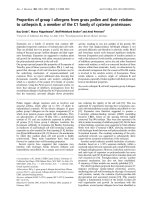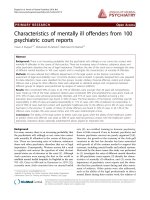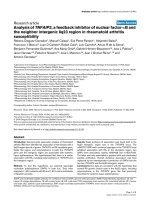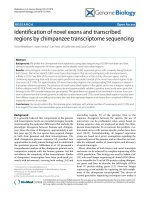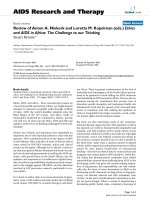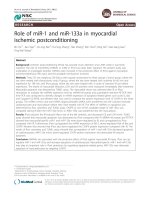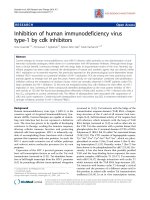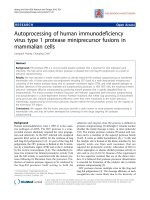Báo cáo y học: "Isolation of mixed subtypes of influenza A virus from a bald eagle (Haliaeetus leucocephalus)" pptx
Bạn đang xem bản rút gọn của tài liệu. Xem và tải ngay bản đầy đủ của tài liệu tại đây (209.45 KB, 4 trang )
SHORT REPOR T Open Access
Isolation of mixed subtypes of influenza A virus
from a bald eagle (Haliaeetus leucocephalus)
Sagar M Goyal
*
, Naresh Jindal, Yogesh Chander, Muthanan A Ramakrishnan, Patrick T Redig, Srinand Sreevatsan
Abstract
From April 2007 to March 2008, cloacal swabs were obtained from 246 casualty raptors recovered by various wild-
life rehabilitation centers in the United States. The swabs were placed in a virus transport medium and transported
to the laboratory on ice packs. At the laboratory, the samples were pooled with each pool consisting of five sam-
ples. All pools (n = 50) were screened for the presence of avian influenza virus (AIV) using a real time reverse tran-
scription-polymerase chain reaction (rRT-PCR); one of the pools was found positive. All five samples in this pool
were tested individually by rRT-PCR; one sample from a bald eagle was found positive. This sample was inoculated
in embryonated chicken eggs for virus isolation and a hemagglutinating virus was isolated. Complete genome
sequencing of the isolate revealed a mixed infection with H1N1 and H2N1 subtypes. Further analysis revealed that
the PB1-F2 gene sequence of H1N1 virus had the N66S virulence-associated substitution. Further studies on ecol-
ogy and epidemiology of AIV in raptors are needed to help understand their role in the maintenance and evolu-
tion of AIV.
Findings
Wild birds are considered natural r eservoirs of avian
influenza virus (AIV) and at least 105 species of wild
birds have been reported to harbor these viruses [1].
The migratory nature of these bird populations may
help disseminate AIV across countries and continents.
Most of the wild birds have been reported to harbor
low pathogenic avian influenza (LPAI) viruses [2-5]
although highly pathogenic avian influenza (HPAI)
viruses have also been isolated from some species [6].
To understand how AIV is evolving in nature, it is
important to identify the AIV subtypes circulating
within wild bird populations.
A number of surveillance programs have been under-
taken to isolate and identify the subtypes of AIV present
in wild bird species e.g., waterfowl and geese [3,7,8] with
limited reports in raptors. Thus, van Borm et al [9]
detected HPAI H5N1 in Thai eagles that were smug gled
intoBelgiumandDucatezetal[10]isolatedHPAI
H5N1 from vultures in Burkina Faso. Due to their carni-
vorous feeding habits, raptors may also play an impor-
tant role in the spread of AIV. Some species of raptors
often feed on ducks and geese and if these birds are car-
rying AIV, raptors may pick up the virus and spread it
elsewhere. In this communica tion, we report on the iso-
lation and characterization of two subtypes of AIV from
a single bald eagle (Haliaeetus leucocephalus).
From April 2007 to March 2008, under an NIH
funded surveillance program on avian influenza, cloacal
swabs were collected from 246 casualty raptors (bald
eagle-81, great horned owl-69, coopers hawk-62, turkey
vulture-28, and black vulture-6) recovered by various
wildlife rehabilitation centers in the U.S. The swabs
were collected in brain heart infusion broth containing
penicillin (500 IU/mL), streptomycin (500 μg/mL), neo-
mycin (150 μg/mL), fungizone (1.5 μg/mL), and genta-
micin (50 μg/mL). After collection, the swabs were
transported on ice to the laboratory in Saint Paul by
overnight shipping. At the laboratory, these samples
were stored frozen at -80°C until tested (within six
months of collection). The experimental plan was to
thaw the samples and pool them in pools of five samples
each followed by a matrix gene based real time reverse
transcription-polymerase chain reaction (rRT-PCR) to
detect the presence of AIV [11]. From the positive
pools, individual sample s were retested by rRT-PCR. All
individual samples positive by rRT-PCR were subjected
to virus isolation by inoculating them into 9-day-old
* Correspondence:
Department of Veterinary Population Medicine, University of Minnesota,
College of Veterinary Medicine, 1333 Gortner Avenue, Saint Paul, MN 55108,
USA
Goyal et al. Virology Journal 2010, 7:174
/>© 2010 Goyal et al; licensee BioMed Central Ltd. This is an Open Access article distributed under the terms of the Creative Commons
Attribution Licens e ( which permits u nrestricted use , distribution, and reproduction in
any medium, provided the original work is properly cited.
specific-pathogen-free embryonated chicken eggs (2 eggs
per sample) via the allantoi c route. The inoculated eggs
were incubated a t 37°C for four days after which they
were chilled and their allantoic fluids tested for hemag-
glutination (HA) using 0.5% chicken erythrocytes. R NA
was extracted from HA positive samples and from a
known AIV (H9N2) isolate using QIAamp viral RNA kit
(Qiagen, Valencia, CA). The RNA was tested for AIV in
a one-step RT-PCR using primers specific to the matrix
gene of AIV [12]. Amplified PCR products were sepa-
rated by gel electrophoresis and a band of 1,027 bp indi-
cated the presence of AIV. Complete genome
sequencing was undertaken using 454 pyrosequencing
recently developed in our laboratory [13] and the
sequences were analyzed for most closely related
sequences in GenBank.
One of the 50 pools was found positive for AIV by
rRT-PCR. All five cloacal samples in the positive pool
were then tested individually by rRT-PCR and a bald
eagle sample was positive. This sample was inoculated
in embryonated chicken eggs for virus isolation and a
hemagglutinating virus was isolated. Whole genome
sequence of this isolate was obtained using the 454-pyr-
osequencing technique that enables resolution beyond
what is possible by standard Sanger sequencing. Contigs
of all eight segment s of influenza A virus were first
identified using GenAssembler software (454 Life
Sciences, Roche, Branford, CT) that detected two dis-
tinct hemagglutinin subtypes - H1 and H2 (GenBank
Accession nos. CY043315 - CY043330). Using standard
BLAST algorithm, GenBank databases were queried for
the most closely related isolates. Sequences of A/green-
winged teal/Ohio/430/1987(H1N1) (CY011040) and A/
mallard/Ohio/37/1986(H2N1) (CY021125) were homo-
logous to those of the bald eagle isolate. Sequences of
all eight segments from these two subtypes were used as
a reference for subsequent alignments performed with
GenMapper (454 Life Sciences, Roche, Branford, CT).
The alignments yielded full genome sequences for two
subtypes,H1N1andH2N1.Thiswasfurtherconfirmed
by manual alignment of all contigs obtained from Gen-
Assembler and GenMapper using Sequencher (Gene
Codes Corporation, Ann Arbor, MI).
On further analy sis, the matrix gene of H1N 1 was
found to be more closely related to A/sanderling/DE/
1258/1986(H6N6). The nucleotides of HA and NA
genes of H2N1 subtype had 99% and 100% identity,
respectively, with those of A/mallard/Ohio/37/1986
(H2N1). The nucleotide identities between each seg-
ment of the two subtypes were also determined
(Table 1). One virulence-associated polymorphism in
PB1-F2 (N66S) was present in the H1N1 virus
(CY043317) [14].
All AIV subtypes (except certain H5 and H7 subtype
combinations) are considered to be LPAI in nature and
generally do not cause apparent disease in avian species.
Even infection with HPAI H5N1 is not fatal to some
waterfowl species [15]. Most o f the surveillanc e studies
[3,4,7,8] have focused on the detection of AIVs from
waterfowl and shorebirds while only a few reports are
available on isolation of AIV from raptors. These
include reports on the isolation of H7 subtype from
saker falcon [16], crested hawk eagles [9], and wild
hooded vultures [10]. In addition, De Marco et al. [17]
reported serologic e vidence of i nfluenza A virus expo-
sure i n diurnal raptors in a rehabilitation facility. In the
winter of 2005-06, there were reports of H5N1-related
mortality among raptor species in Europe and Asia,
including eagle owls (Bubo bubo), buzzards (Buteo lago-
pus), and peregrine falcon (Falco peregrinus) (ProMED).
This is the first report on isolation of AIV in a Bald
eagle from the U.S. The bald eagle in question was
recovered from Gloucester County, Virginia in March,
2008. In general, samples from injured raptors are col-
lected immediately after admission to t he Rehabilitation
Center and before mixing with raptors already residing
at the Rehabilitation Center. These procedures were in
place when the bald eagle was brought to the Rehabilita-
tion Center. In addition, the raptors residing at the
Rehabilitation Center were AIV negative, thus ruling out
the possibility of the bald eagle acquiring AIV infection
at the Rehabilitation Center.
The bald eagle, a bird of prey, is a protected and rev-
ered species in the US. In addition to fish, these birds
prey on ducks and geese [18], resulting in possible expo-
sure to AIV. The AIV subtypes obtained from r aptors
probably reflect the virus types present in its prey. The
raptors may also be infect ed from domestic poultry
especially in areas where dead poultry carca sses are dis-
carded in the open or in the presence of open abattoir
systems. Though we do not know the role of raptors in
virus transmission to domestic poultry or wild birds at
present, such a possibility does exist. Since a large pool
of influenza subtypes circulates in waterfowl populations
[3,7], which are preys of raptors, further studies are
needed to determine the prevalence of different AIV
subtypes in raptors and their impact vis-a-vis transmis-
sion to domestic poultry directly or in a chain invol ving
raptors-waterfowl-domestic birds. Perhaps more impor-
tantly, raptors, especially eagles, may serve as sentinels
for influenza viruses circulating in th e environment
from which they obtain their prey.
The genome sequences of this bald eagle isolate
revealed a mixture of H1N1 and H2N1 subtypes. Phylo-
genetic analysis identified a high degree of sequence
similarity of all segments of these two subtypes to
Goyal et al. Virology Journal 2010, 7:174
/>Page 2 of 4
influenza A viruses circulating in wild waterfowl popula-
tions suggesting that the bald eagle possibly acquired
the viruses while preying on infected wild birds. Our
results indicate the need to study the raptor population
in detail to gain better understanding of AIV ecology
and epidemiology.
Abbreviations
AIV: avian influenza virus; HPAI: highly pathogenic avian influenza virus; LPAI:
low pathogenic avian influenza virus; NIH: National Institutes of Health; rRT-
PCR: real time reverse transcriptase polymerase chain reaction; RT-PCR:
reverse transcriptase polymerase chain reaction
Acknowledgements
This work has been funded in whole or in part with federal funds from the
National Institute of Allergy and Infectious Diseases, National Institutes of
Health, Department of Health and Human Services, under Contract No.
HHSN266200700007C. Its contents are solely the responsibility of the authors
and do not necessarily represent the official views of the NIH.
Authors’ contributions
PTR was responsible for collection of samples from bald eagles. SMG and SS
were responsible for overall coordination and planning of the study. NJ, YC,
Table 1 Genetic similarity between A/bald eagle/Virginia/Sg-00154/2008(mixed)) and reference strains available in
GenBank (Accession date: 1 Feb 2010)
Gene
segment
GenBank Accession number of
Bald eagle isolate
a
Bald eagle isolate showing the highest
nucleotide identity with:
Nucleotide identity between two subtypes
of bald eagle isolate (%)
Virus Name (GenBank Accession
number)
Percent
identity
PB2 CY043315 A/green-winged teal/Ohio/430/1987
(H1N1) (CY011047)
99% 92
CY043316 A/mallard duck/New York/157/1986
(H3N6) (CY014871)
99%
PB1 CY043317 A/green-winged teal/Ohio/430/1987
(H1N1) (CY011046)
99% 93
CY043318 A/mallard/Ohio/37/1986(H2N1)
(CY021131)
99%
PA CY043319 A/green-winged teal/Ohio/430/1987
(H1N1) (CY011045)
99% 89
CY043320 A/mallard/Ohio/48/1986(H3N2)
(CY020722)
99%
HA CY043321 A/green-winged teal/Ohio/430/1987
(H1N1) (CY011040)
99% 68
CY043322 A/mallard/Ohio/37/1986(H2N1)
(CY021125)
99%
NP CY043323 A/green-winged teal/Ohio/430/1987
(H1N1) (CY011043)
100% 95
CY043324 A/mallard/Ohio/37/1986(H2N1)
(CY021128)
99%
NA CY043325 A/green-winged teal/Ohio/430/1987
(H1N1) (CY011042)
100% 96
CY043326 A/mallard/Ohio/30/1986(H2N1)
(CY017695)
100%
M CY043327 A/sanderling/DE/1258/1986(H6N6)
(CY005421)
99% 97
CY043328 A/mallard duck/New York/157/1986
(H3N6) (CY014866)
99%
NS CY043329 A/green-winged teal/Ohio/430/1987
(H1N1) (CY011044)
100% 80
CY043330 A/mallard duck/New York/180/1986
(H4N9) (CY014861)
99%
a
The GenBank accession number appearing in the top row of each segment represents the H1N1 subtype sequence while that in the bottom row represents the
H2N1 subtype.
Goyal et al. Virology Journal 2010, 7:174
/>Page 3 of 4
and MAR contributed in virus isolation, RT-PCR, sequencing and sequence
analysis. NJ, SMG, and SS drafted the manuscript. All authors’ have read and
approved final manuscript.
Competing interests
The authors declare that they have no competing interests.
Received: 23 March 2010 Accepted: 28 July 2010
Published: 28 July 2010
References
1. Stallknecht DE, Shane SM: Host range of avian influenza virus in free-
living birds. Vet Res Commun 1988, 12:125-141.
2. Alexander DJ: An overview of the epidemiology of avian influenza.
Vaccine 2007, 25:5637-5644.
3. Munster VJ, Baas C, Lexmond P, Waldenström J, Wallensten A, Fransson T,
Rimmelzwaan GF, Beyer WE, Schutten M, Olsen B, Osterhaus ADME,
Fouchier RAM: Spatial, temporal, and species variation in prevalence of
influenza A viruses in wild migratory birds. PLoS Pathol 2007, 3:e61.
4. Chen H, Smith GJD, Zhang SY, Qin K, Wang J, Li KS, Webster RG, Peiris JSM,
Guan Y: Avian flu: H5N1 virus outbreak in migratory waterfowl. Nature
2005, 436:191-192.
5. Ferro PJ, El-Attrache J, Fang X, Rollo SN, Jester A, Merendino T, Peterson MJ,
Lupiani B: Avian influenza surveillance in hunter-harvested waterfowl
from the Gulf Coast of Texas (November 2005 - January 2006). J Wildlife
Dis 2008, 44:434-439.
6. Smith GJD, Vijaykrishna D, Ellis TM, Dyrting KC, Leung YHC, Bahl J,
Wong CW, Kai H, Chow MKW, Duan L, Chan ASL, Zhang LJ, Chen H,
Luk GSM, Peiris JSM, Guan Y: Characterization of avian influenza viruses A
(H5N1) from wild birds, Hong Kong, 2004-2008. Emerg Infect Dis 2009,
15:402-407.
7. Krauss S, Walker D, Pryor SP, Niles L, Chenghong L, Hinshaw VS,
Webster RG: Influenza A viruses of migrating wild aquatic birds in North
America. Vector-Borne Zoo Dis 2004, 4:177-189.
8. Wallensten A, Munster VJ, Latorre-Margalef N, Brytting M, Elmberg J,
Fouchier RAM, Fransson T, Haemig PD, Karlsson M, Lundkvist A,
Osterhaus ADME, Stervander M, Waldenstrom J, Olsen B: Surveillance of
influenza A virus in migratory waterfowl in northern Europe. Emerg Infect
Dis 2007, 13:404-411.
9. Van Borm S, Thomas I, Hanquet G, Lambrecht B, Boschmans M, Dupont G,
Decaestecker M, Snacken R, van den Berg T: Highly pathogenic H5N1
influenza virus in smuggled Thai eagles, Belgium. Emerg Infect Dis 2005,
11:702-705.
10. Ducatez MF, Tarnagda Z, Tahita MC, Sow A, de Landtsheer S, Londt BZ,
Brown IH, Osterhaus ADME, Fouchier RAM, Ouedraogo JB, Muller CP:
Genetic characterization of HPAI (H5N1) viruses from poultry and wild
vultures, Burkina Faso. Emerg Infect Dis 2007, 13:611-613.
11. Spackman E, Senne DA, Myers TJ, Bulaga LL, Garber LP, Perdue ML,
Lohman K, Daum LT, Suarez DL: Development of a real-time reverse
transcriptase PCR assay for type A influenza virus and the avian H5 and
H7 hemagglutinin subtypes. J Clin Microbiol 2002, 40:3256-3260.
12. Chan CH, Lin KL, Chan Y, Wang YL, Chi YT, Tu HL, Shieh HK, Liu WT:
Amplification of the entire genome of influenza A virus H1N1 and H3N2
subtypes by reverse-transcription polymerase chain reaction. J Virol
Methods 2006, 136:38-43.
13. Ramakrishnan MA, Tu ZJ, Singh S, Chockalingam AK, Gramer MR, Wang P,
Goyal SM, Yang M, Halvorson DA, Sreevatsan S: The feasibility of using
high resolution genome sequencing of influenza A viruses to detect
mixed infections and quasispecies. PLoS One 2009, 4:e7105.
14. Conenello GM, Palese P:
Influenza A virus PB1-F2: a small protein with a
big punch. Cell Host Microbe 2007, 2:207-209.
15. Keawcharoen J, van Riel D, van Amerongen G, Bestebroer T, Beyer WE, van
Lavieren R, Osterhaus ADME, Fouchier RAM, Kuiken T: Wild ducks as long-
distance vectors of highly pathogenic avian influenza virus (H5N1).
Emerg Infect Dis 2008, 14:600-607.
16. Magnino S, Fabbi M, Moreno A, Sala G, Lavazza A, Ghelfi E, Pirovano G,
Gasperi E: Avian influenza virus (H7 serotype) in a saker falcon in Italy.
Vet Rec 2000, 146:740.
17. De Marco MA, Foni E, Campitelli L, Raffini E, Delogu M, Donatelli I: Long-
term monitoring for avian influenza viruses in wild bird species in Italy.
Vet Res Commun 2003, 27:107-114.
18. Stalmaster MV: The Bald Eagle. Universe Publishing, New York 1987.
doi:10.1186/1743-422X-7-174
Cite this article as: Goyal et al.: Isolation of mixed subtypes of influenza
A virus from a bald eagle (Haliaeetus leucocephalus). Virology Journal
2010 7:174.
Submit your next manuscript to BioMed Central
and take full advantage of:
• Convenient online submission
• Thorough peer review
• No space constraints or color figure charges
• Immediate publication on acceptance
• Inclusion in PubMed, CAS, Scopus and Google Scholar
• Research which is freely available for redistribution
Submit your manuscript at
www.biomedcentral.com/submit
Goyal et al. Virology Journal 2010, 7:174
/>Page 4 of 4
